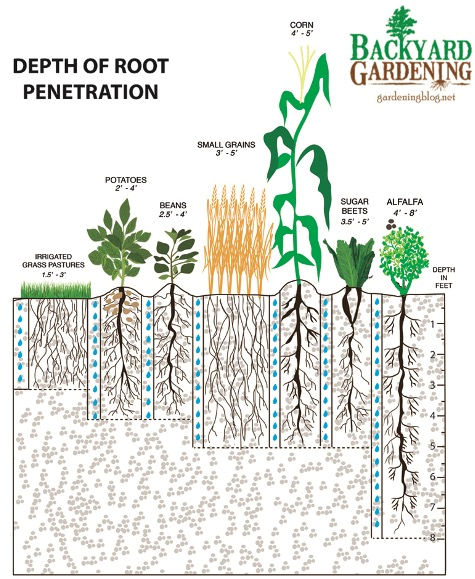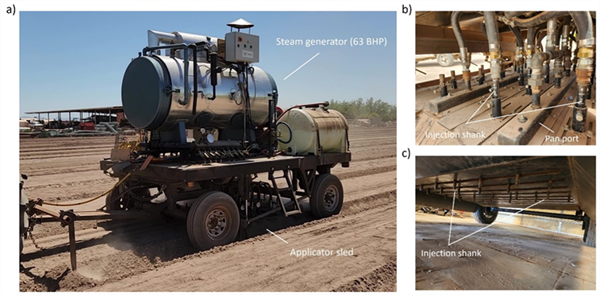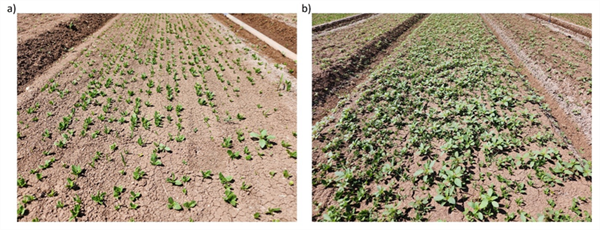
Author’s Note:
I recognize alfalfa is not a vegetable crop per se, but I also recognize that alfalfa has become an emblematic crop for desert agriculture, particularly in the water resource arena. In recent weeks alfalfa production in Arizona has come under intense scrutiny and criticism by state leaders. The Arizona Attorney General has been quoted as stating that alfalfa production in Arizona is “stupid” and leases of state land being used for alfalfa production are being considered for cancelation (Fischer, 4 October 2023). This is a point of concern for Arizona agriculture and the possible regulatory implications regarding what crops should be irrigated and grown. Alfalfa is an important crop, and it is grown in Arizona for good reasons, some of which are described in this article.
Merits of Alfalfa Production in the Desert Southwest
Alfalfa is a major crop in Arizona, the desert Southwest, and most parts of the United States. Alfalfa has been planted to the largest acreage of any crop in Arizona for several years with about 260,000 acres being grown in 2023 (USDA, 2023 and Table 1).
Alfalfa is an extremely important crop due to its rich nutritional value as feed for animals, particularly cattle, horses, and sheep. In Arizona and the desert Southwest alfalfa has high value as nutritious feed for dairy and beef cattle. Most fresh dairy products are sold within about 300 miles of their point of origin.
Arizona’s population of 7.3 million people has a high demand for fresh dairy products. Arizona has 90% of the population living in urban areas. Over 6 million people in Arizona reside in Maricopa, Pinal, and Pima counties in the central and southern part of the state (82% of Arizona’s population). It is not surprising that there is a high concentration of dairies in central Arizona and alfalfa is grown near the dairies to provide a local source of high-quality forage.
Alfalfa is often demonized as a very poor crop choice in Arizona and the desert, usually by people outside of agriculture who are probably well-intentioned but not well-informed. These attitudes and opinions serve to remind us of Dwight D. Eisenhower’s statement at Bradley University in September 1956 when he said, “You know, farming looks mighty easy when your plow is a pencil, and you’re a thousand miles from the corn field.”
People who criticize and complain about alfalfa production in Arizona should consider their needs for fresh dairy products. If they are drinking milk, eating ice cream, yogurt, and butter they are consuming alfalfa as secondary consumers after the dairy cattle have rendered fresh milk from a healthy diet including alfalfa. Thus, Arizonans are the direct beneficiaries of local alfalfa production.
In the case of alfalfa, it is in fact an excellent crop for Arizona and the desert Southwest and a favorite among agronomists (crop and soil scientists), farmers, and farm managers (Putnam, 2015; Mostafa, 2015; and Yost, 2020). Alfalfa is an important crop in the desert Southwest and it provides important contributions to crop production system efficiency agronomically, economically, and environmentally. Several good reasons for growing alfalfa in the desert are summarized in the following points:

Figure 1. Alfalfa rooting depth compared to several other common
crops. Source: Backyard Gardening Blog
Alfalfa production supports other food products, primarily dairy and meat. Reductions in alfalfa acres will in turn require a greater reliance on food from non-local sources, including those imported from abroad. This will likely increase food prices and extend the supply chain.
This point was illustrated in the following written testimony provided by the Family Farm Alliance to the U.S. House of Representatives Subcommittee on Water, Wildlife and Fisheries in March 2023 (U.S. House of Representatives Natural Resources Committee, 2023):
"The Western U.S. is a critical part of what has long been a proud national agricultural powerhouse, where our country consistently has run an agricultural trade surplus. But in 2019, for the first time in more than 50 years, the U.S. agriculture system ran an agricultural trade deficit, importing more than it exported. The USDA forecasts the U.S. will again run a deficit in 2023 for the third time since 2019. This growing deficit is driven primarily by our dependence on imported Mexican fruits and vegetables (Politico Pro DataPoint). Increased reliance on foreign food has never been, and should never be a policy our Nation has intentionally embraced."
Agri-Environmental Scheme of Agriculture
It is interesting to note that alfalfa is recognized as an important crop in what is often referred to as “sustainable agriculture” or “regenerative agriculture” that emphasizes the use of natural systems for enhancing soil health and plant community ecology.
Alfalfa has been a popular a crop rotation component in Europe, and encouraged globally, as an element of the Agri-Environmental Scheme (AES), which is intended to reduce the impacts of “commercial” agriculture intensification on the environment (Gonzalez del Portillo, et al. 2022).
The Agri-Environmental Scheme (AES) offers the following attributes of alfalfa which are consistent with our basic agronomic understanding for many decades:
• Alfalfa also may help reduce the impacts of climate change due to canopy cover of the soil for a longer period than any other crop, alfalfa is envisioned as a leading option for soil carbon sequestration, also known as “regenerative agriculture,” especially with the need to decrease carbon emissions and introduce the carbon credits initiative.
• Alfalfa is a rich habitat for wildlife allowing for a diversity of local niches and preserving many endangered species from different animal families.
• Alfalfa fields are important contributors to the biodiversity of agricultural systems by functioning as insectaries for beneficial insects, many of which are pollinators or natural enemies that play important roles in the low desert agroecosystem.
• Beneficial insects move from alfalfa fields into other crops, where they play crucial roles in pollination and biological control.
• These roles reduce the reliance on synthetic insecticides, which if used incorrectly could have negative impacts on human, animal, and environmental health.
• Western alfalfa production, due primarily to irrigation and the vigorous plants that grown, provides a rich habitat for insects, which enhances the crop ecology.
• The year-round insectary characteristic allows alfalfa to play an important role in insecticide resistance management by serving as a refuge, i.e., aphids and whiteflies.
Arizona Crop Acreages 2022
|
Crop |
Seasonal Water Use (inches) |
Total Acres (2022) |
|
Alfalfa |
74.3 |
260,000 |
|
Cotton |
41.2 |
86,000 |
|
Wheat |
25.8 |
|
|
Corn |
32 |
44,000 |
|
Lettuce |
8.5 |
27,000 |
|
Broccoli |
19.7 |
11,600 |
|
Cauliflower |
18.6 |
6,000 |
|
Lemons |
39.1 |
6,700 |
|
Spring Cantaloupes |
20.5 |
6,000 |
*Seasonal water use estimates from Erie, et al. 1981 unless otherwise noted.
**Norton and Silvertooth, 2001
References:
Del Portillo, D.G, B. Arroyo & M.B. Morales (2022) The adequacy of alfalfa crops as an agri-environmental scheme: A review of agronomic benefits and effects on biodiversity. Journal for Nature Conservation 69(2):126253.
Erie, L.J., O.A French, D.A. Bucks, and K. Harris. 1981. Consumptive Use of Water by Major Crops in the Southwestern United States. United States Department of Agriculture, Conservation Research Report No. 29.
Fischer, H. 4 October 2023. Arizona cancels a lease for farm that exports alfalfa to Middle East. Tucson Daily Star.
Norton, E.R. and J.C. Silvertooth. 2001. Evaluation of a drip vs. furrow irrigated cotton production system. Cotton, A College of Agriculture Report Series P-125, University of Arizona, Tucson, AZ. p. 126-132.
Mostafa, A.M. 2015. The Benefits of Alfalfa to the Southwest Ecosystem. Arizona Agriculture.
Putnam, D. 2015. Why alfalfa is the best crop to have in a drought. University of California- Davis. Alfalfa and Forage News.
U.S. House of Representatives Committee on Natural Resources; The Water, Wildlife and Fisheries Subcommittee. Farm Family Alliance written testimony, March 2023.
USDA. 2022. State Agriculture – Arizona.
USDA. 2023. News Release: NASS, 30 June 2023 Arizona crop report.
USDA. 2023. October 2023 Pacific Region crop production report.
Yost, M., N. Allen, E. Creech, D. Putnam, J. Gale & G. Shewmaker. 2020. Ten Reasons Why Alfalfa is Highly Suitable for the West. Utah State University Extension.
Hi, I’m Chris, and I’m thrilled to be stepping into the role of extension associate for plant pathology through The University of Arizona Cooperative Extension in Yuma County. I recently earned my Ph.D. in plant pathology from Purdue University in Indiana where my research focused on soybean seedling disease caused by Fusarium and Pythium. There, I discovered and characterized some of the first genetic resources available for improving innate host resistance and genetic control to two major pathogens causing this disease in soybean across the Midwest.
I was originally born and raised in Phoenix, so coming back to Arizona and getting the chance to apply my education while helping the community I was shaped by is a dream come true. I have a passion for plant disease research, especially when it comes to exploring how plant-pathogen interactions and genetics can be used to develop practical, empirically based disease control strategies. Let’s face it, fungicide resistance continues to emerge, yesterday’s resistant varieties grow more vulnerable every season, and the battle against plant pathogens in our fields is ongoing. But I firmly believe that when the enemy evolves, so can we.
To that end I am proud to be establishing my research program in Yuma where I will remain dedicated to improving the agricultural community’s disease management options and tackling crop health challenges. I am based out of the Yuma Agricultural Center and will continue to run the plant health diagnostic clinic located there.
Please drop off or send disease samples for diagnosis to:
Yuma Plant Health Clinic
6425 W 8th Street
Yuma, AZ 85364
If you are shipping samples, please remember to include the USDA APHIS permit for moving plant samples.
You can contact me at:
Email: cdetranaltes@arizona.edu
Cell: 602-689-7328
Office: 928-782-5879
Last month, we investigated the use of applying steam to the soil to control weeds in baby leaf spinach. In the study, we utilized the prototype steam applicator described in previous UA Veg IPM articles to inject steam into the soil prior to planting. The concept is to heat the soil to levels sufficient to kill soilborne pathogens and weed seeds (140 °F > 20 minutes). The device is principally comprised of a 63 BHP steam generator mounted on an elongated bed shaper (Fig. 1a). The apparatus applies steam via shank injection and from rectangular ports on top of the bed shaper. After cooling (< ½ a day), the crop is planted into the disinfested soil.
In the trial, the unit’s bed shaper (84” wide) was outfitted with twenty-four steam injection shanks positioned to inject steam into the soil at a depth of about 2” (Fig. 1b,1c). Six injectors were in a rank towards the front of the bed shaper with each injector spaced about 10.4” apart. Three additional ranks of 6 injectors, also with 10.4” injector spacing, were positioned behind the first rank. Ranks of injectors were offset such that the spacing between injectors across the frontal cross-section of the bed shaper was 2.6”. Travel speed was 0.20 mph.
Results showed that steam treatment provided very good control of broadleaf weeds (89%) and moderate control of grassy weeds (65%) (Table 1, Fig. 3). Combined, overall weed control was 80%. The predominant species at the site were nettleleaf goosefoot, thumble pigweed, ground cherry, common purslane and junglerice. Although weed densities were still high in the steam treated plots (1.8 weeds/ft2), hand weeding times were reduced by a factor of 5 as compared to the untreated control.
Work rates and fuel costs were considered marginally acceptable at 0.14 ac/hr and $597/ac, respectively. However, it is estimated that travel speed can be increased by 50% by operating the device when initial soil temperatures are high (>130 °F) as compared to this study where soil temperatures were moderate (110 °F) since much less heat energy is needed to raise soil temperatures to target levels. If a 50% increase in travel speed were realized, work rate would be improved to 0.20 ac/hr (5 hr/ac) and fuel costs would be about $400/ac. These values are very reasonable and show good potential for use of the technique in spinach or spring mix crops where costs for hand weeding are very high. Later this summer, we plan to conduct trials in high temperature soils to determine the maximum travel speeds that can be utilized for effective weed control using steam.
If you are interested in soil steaming and would like a demo or to evaluate the machine on your farm, please let me know. I would be happy to collaborate with you.
Acknowledgements
This work is supported by the Arizona Specialty Crop Block Grant Program and the Crop Production and Pest Management grant no. 2021-70006-35761 /project accession no. 1027435 from USDA-NIFA. We appreciate their support. Any opinions, findings, conclusions, or recommendations expressed in this publication are those of the author(s) and do not necessarily reflect the view of the U.S. Department of Agriculture.

Fig. 1. a) Band-steam applicator principally comprising a 63 BHP steam generator
mounted on a bed-shaper applicator sled. Steam applicator sled b) top view and
c) bottom view.
Table 1. Weed density and control of weeds with soil applied steam in baby leaf spinach trial.


Fig. 3. Weed control with steam in spinach. Steam was applied to the soil at a 2”
depth via shank injection prior to planting (a) and untreated control (b).
Do you know the botanical families of all the small acreage specialty crops grown in the low desert?
The family is an important factor in deciding what type of herbicides can be used for weed control in our crops. For some of us it has been difficult to keep track of the families. I found a table published in this Newsletter by our Applied Weed Science maestro Barry Tickes.
Hope you like the chart with the botanical families of many of these crops and herbicides that might be used on them.
|
Botanical |
Crops |
Possible herbicides |
|
Brassica |
Bok Choy, Napa, Mizuna, Kale, Kohlrabi, Turnip Greens, Mustard, Tatsoi, Arugula, Radish, Daikon |
Prefar, Trifluralin, Dacthal, Stinger, Poast, Select |
|
Umbelliferae |
Cilantro, Celery, Coriander, Parsley, Dill, Parsnip, Fennel |
Prefar, Lorox, Poast, Prometryne |
|
Aster |
Endive, Escarole, Chicory, Radicchio |
Prefar, Trifluralin, Kerb, Fusilade, Poast, Select |
|
Amaranth |
Spinach, Chard, Beets |
Roneet, Dual Magnum, Poast, Select |

This time of year, John would often highlight Lepidopteran pests in the field and remind us of the importance of rotating insecticide modes of action. With worm pressure present in local crops, it’s a good time to revisit resistance management practices and ensure we’re protecting the effectiveness of these tools for seasons to come. For detailed guidelines, see Insecticide Resistance Management for Beet Armyworm, Cabbage Looper, and Diamondback Moth in Desert Produce Crops .
VegIPM Update Vol. 16, Num. 20
Oct. 1, 2025
Results of pheromone and sticky trap catches below!!
Corn earworm: CEW moth counts declined across all traps from last collection; average for this time of year.
Beet armyworm: BAW moth increased over the last two weeks; below average for this early produce season.
Cabbage looper: Cabbage looper counts increased in the last two collections; below average for mid-late September.
Diamondback moth: a few DBM moths were caught in the traps; consistent with previous years.
Whitefly: Adult movement decreased in most locations over the last two weeks, about average for this time of year.
Thrips: Thrips adult activity increased over the last two collections, typical for late September.
Aphids: Aphid movement absent so far; anticipate activity to pick up when winds begin blowing from N-NW.
Leafminers: Adult activity increased over the last two weeks, about average for this time of year.







